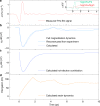Ultrafast terahertz magnetometry
- PMID: 32843645
- PMCID: PMC7447779
- DOI: 10.1038/s41467-020-17935-6
Ultrafast terahertz magnetometry
Abstract
A material's magnetic state and its dynamics are of great fundamental research interest and are also at the core of a wide plethora of modern technologies. However, reliable access to magnetization dynamics in materials and devices on the technologically relevant ultrafast timescale, and under realistic device-operation conditions, remains a challenge. Here, we demonstrate a method of ultrafast terahertz (THz) magnetometry, which gives direct access to the (sub-)picosecond magnetization dynamics even in encapsulated materials or devices in a contact-free fashion, in a fully calibrated manner, and under ambient conditions. As a showcase for this powerful method, we measure the ultrafast magnetization dynamics in a laser-excited encapsulated iron film. Our measurements reveal and disentangle distinct contributions originating from (i) incoherent hot-magnon-driven magnetization quenching and (ii) coherent acoustically-driven modulation of the exchange interaction in iron, paving the way to technologies utilizing ultrafast heat-free control of magnetism. High sensitivity and relative ease of experimental arrangement highlight the promise of ultrafast THz magnetometry for both fundamental studies and the technological applications of magnetism.
Conflict of interest statement
The authors declare no competing interests.
Figures



References
-
- Stöhr, J. & Siegmann, H. C. Magnetism From Fundamentals to Nanoscale Dynamics. (Springer-Verlag, Berlin Heidelberg, 2006).
-
- Chappert C, Fert A, Van Dau FN. The emergence of spin electronics in data storage. Nat. Mater. 2007;6:813–823. - PubMed
-
- Parkin SSP, Hayashi M, Thomas L. Magnetic domain-wall racetrack memory. Science. 2008;320:190–194. - PubMed
-
- Chumak AV, Vasyuchka VI, Serga AA, Hillebrands B. Magnon spintronics. Nat. Phys. 2015;11:453–461.
-
- Cornelissen LJ, Liu J, Duine RA, Ben Youssef J, Van Wees BJ. Long-distance transport of magnon spin information in a magnetic insulator at room temperature. Nat. Phys. 2015;11:1022–1026.
Grants and funding
LinkOut - more resources
Full Text Sources
Research Materials

